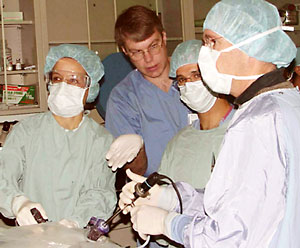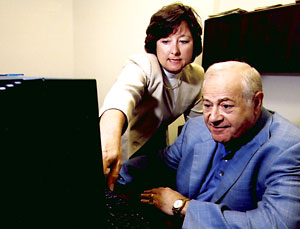


C.M.E. Now
What’s new in medicine?
Continuing Medical Education offers the
subjects professionals need to know—now.

Examples of CME-Online’s many course offerings.
Visit the CME home page for more information

“Our programs in allergy and immunology are inclusive of all of our full-time and private practice faculty members. That builds an academic camaraderie among members of the division.”
PHILIP E. KORENBLAT, MD, CME ACTIVITY CHAIR

“CME-Online offers convenient, well-structured courses with appropriate graphics.”
DENNIS P. OWENS, MD, PHD '82, PSYCHIATRY ASSOCIATES OF KANSAS CITY, HAS EARNED 22 CREDITS ONLINE



![]()
THREE WEEKS AFTER anthrax-laden
letters contaminated U.S. media and government offices last October, the
School of Medicine’s Office of Continuing Medical Education rolled
out a new course on bioterrorism and public health.
Infectious disease experts discussed spotting infectious agents. Carol
S. North, MD, professor of psychiatry and an authority on post-traumatic
stress disorder following major disasters, outlined the psychological
impacts and ways to deal with them. A Muslim professor from the Hilltop
campus explained the social costs of the current cultural tensions. Other
experts addressed issues of hospital preparedness.
“We want to respond quickly to physicians’ educational needs,” explains Gail M. Goodenow, director of continuing medical education (CME) at Washington University.
To get word out about the bioterrorism course, the department used e-mails and facsimiles to complement traditional brochures. Nearly 300 physicians attended.
The bioterrorism program exemplifies the changes taking place in continuing medical education. New topics, new formats and new ways of reaching physicians with them are developing at an accelerating pace, mirroring the dramatic changes within the medical profession itself.

Hands-on training, such as this laparoscopic procedure, is among the ways CME gives physicians the healing edge.
In an environment where new discoveries, technologies and treatments revolutionize medical care on a daily basis, ongoing education becomes ever more critical. Doctors require continuing education credits for their annual licensing, but much more importantly, they need up-to-the-minute information to deliver the best care to their patients.
To keep abreast of these changes in medical knowledge, the CME staff depend on medical school faculty who, Goodenow says, are eager to share their knowledge.
“They see it as part of their role as educators to do undergraduate, graduate and continuing education, part of their mission as academicians,” she explains. “Our faculty initiate and develop content for CME programs—we facilitate the planning and accreditation.”
Physicians know what’s new in medicine. “In many cases, our faculty are doing the research,” Goodenow says. “Faculty experts know what research should be translated into continuing education and they communicate that expertise in CME courses.”
And they do it prolifically. Last year, the CME office presented 275 programs— 137 courses and 138 rounds or in-house conferences. These offerings added up to nearly 7,500 hours of instruction and 109,100 credit hours granted.
Lining up teachers, then, is only part of the challenge. How to deliver information in a manner that is most useful and accessible to physician-learners is an equally important aspect of CME.
“Contemporary approaches to CME must be available to the health professional at the teachable moment. To be most effective, the learner needs to access information whenever a question arises,” says W. Edwin Dodson, MD, associate vice chancellor for continuing medical education and associate dean for medical school admissions. “With ever-increasing time demands on physicians, CME-Online will become all the more important to practicing physicians.”
Not surprisingly, Web-based learning has proved to be one of the most effective new methods for delivering CME instruction. CME-Online has shown steady growth since its introduction in 1999. Recently the office began promoting CME-Online through the Washington University Medical Center Alumni Association (WUMCAA), whose members are one of CME’s major constituencies. “The response has been great,” Goodenow says. “We have nearly 400 new participants since April.”
WUMCAA was instrumental in the development of the majority of CME-Online courses via its educational funding. With the help of alumni, the number of available courses has grown steadily over the past year.
“The Alumni Association’s support has allowed us to extend the scope and reach of our educational programs for physicians in practice,” says Dodson. “As a result, physicians anywhere have ready access to educational material crafted by our faculty.”
Most CME-Online programs are developed from an earlier didactic lecture edited for online presentation. The advantages for participating physicians are numerous: They can study the material at any time of day or night, at their own pace; instructors make themselves available for questions and discussion via e-mail, and participants can test repeatedly until they feel comfortable with the new knowledge. Authors of CME-Online courses review and update their courses as necessary, so online material is as current as the latest discovery.
And even as CME-Online is taking off—current course topics range from osteoporosis to sleep apnea, from prostate cancer to heart disease—CME staff continue to explore alternative methods for delivering medical information to physicians, such as DVD or CD-ROM.
In today’s rapidly changing health care environment, primary care providers are expected to do more and more, and they may need to perform procedures in their offices. For them, traditional didactic teaching methods are often utilized. One of these programs may include, for example, hypertension, coronary artery disease, cholesterol and lipids under the broader category of cardiac health. Other CME programs deal with a category of patient care, such as women’s health.
“We also do programs that are overviews of best practices,” Goodenow says. “These can be multispecialty-oriented programs. Presentations may include multiple illnesses, assessment and diagnosis, and a literature review to present a treatment plan based on evidence our faculty have researched.”

CME director Gail M. Goodenow with Phillip E. Korenblat, MD, professor of clinical medicine, who says “the best way to learn is to teach.”
This kind of training relieves the practicing physician of the need to investigate numerous treatment protocols to discover the most effective.
Other CME courses provide traditional hands-on opportunities for physicians to acquire new skills and techniques while taking advantage of new educational technologies. For example, in a current offering on urologic laparoscopic techniques, participants attend lectures, view videotapes and actually practice procedures in the laboratory. They also watch the faculty perform operations via two-way audio/video broadcasts that connect the operating room and the conference room, a setup that allows spontaneous exchange and faculty-learner interaction.
With all of these offerings, the CME program reaches out to a diverse audience. Enrollees are primarily physicians, physicians-in-training, residents and fellows. Nearly half of the CME credits given last year were to School of Medicine and local referring physicians participating in ongoing rounds. But with national accreditation, course offerings also draw physicians from across the nation and around the world.
With the help of faculty and alumni, the continuing medical education team works hard to keep its offerings complete with leading-edge medical discoveries offered through a variety of educational formats.
The quality of instruction at the School of Medicine, coupled with multiple learning options offered by the CME program, keeps Washington University among the most comprehensive resources for practicing physicians. Since its debut, CME-Online has proved popular and it should continue to grow, perhaps as the most practical and convenient of these many options.
“The goal of CME is to move the latest information
from the academic setting into the medical community,” says Dodson,
“where physicians put it into practice—helping people now.”
![]()
![]()